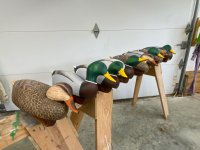Well, I did have another project going...
Back at the first of July I was visiting my friend in Nags Head, NC and while I was there he gifted me these two goose decoys from his family. They were both made by Capt Henry M. Doxey of Currituck County, NC (1924-2021). Capt Doxey had served in the US Merchant Marine in WW2. He was a hunting guide on Currituck Sound, and was a tugboat captain. I was told that Capt Doxey could usually be found sitting in front of his shed making working decoys. Perhaps not as stylish as some others, He made his decoys from locally available materials for rugged use on the Currituck Sound.
These decoys had been gathering dust in Capt Doxey's shed until his death a few years ago, and later in my friend's garage.
This canvas and wire bodied decoy was either undergoing some repairs or was never finished. The mattress ticking material was folded up and tucked inside the wire frame. I received it exactly as seen in this first picture. My friend dates it to the mid 50s or 60s. Close examination of the boards indicated to me that it was probably cut with a handsaw. My friend verified that Capt Doxey did not have any power tools. The decoy head is very plain, without any detail whatsoever. The head and back board have some type of caulk or putty compound filling in the gap where they are joined.

I took the opportunity to make lots of notes and measurements to use as a go-by when I make another decoy, then I began to finish this classic bird. I was worried about that joint where the head and body met, so I mixed up some marine epoxy and sawdust, and filleted the gap there, and ran a bead of it along the back board where it meets the bottom board. No more concerns, now.


The mattress ticking was already cut perfectly to fit over the decoy. The material was sufficiently thick for a strong covering. I stretched the material over the body and secured it with staples. A thinned mixture of Titebond III was painted over the area to help stiffen and provide some waterproofing to the material. I sanded the head a bit to give it some cheeks, but I didn't want to take it too far from its original design and shape. I also ran two rows of string on each side between the wires to help define the body.


I already had some canvas webbing for a bottom band. Once that was secured, the entire bird was painted again with the Titebond III and allowed to dry.
Here's the final Paint job. I tried to imitate the colors of the other bird I received, although I painted it with a different scheme. The decoy measures 23 inches from beak to tail, and is 10 inches tall. I will have to give it a float this winter. I hope Capt Doxey would approve.

A couple different views:


Finally, here is a picture of the other decoy from my friend. It's pretty used up and the covering is holed in places and a bit brittle. I think it dates to the mid 1950s or 60s. Again, this was a working bird, not the prettiest gal, but If this bird could talk, I bet it would be able to tell me of many a sunrise on Currituck Sound, back in the day. It will spend the rest of its days in my den.
































